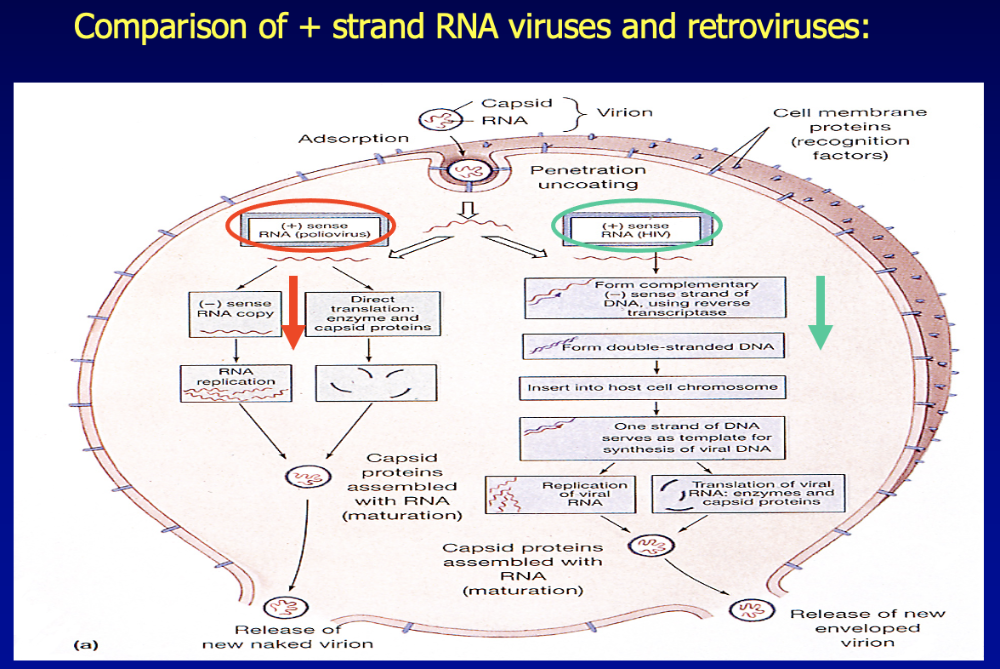Replication of RNA viruses II
2/07
(-) strand RNA viruses
- not infectious by self
- RdRp is INSIDE the viron, bc needed for transcription to be done upon entering cell
- transcription/translation
- RdRp used to make mRNA from (-) strand viral RNA
- once transcribed, can translate mRNA -> single proteins (NOT polyproteins)
- replication
- makes fullsized (+) RNA (NOT mRNA) intermediate, but is NOT translated
- instead, use (+) RNA
as template to make more (-) RNA
notes
(-) rna viruses
- their genomes are opposite polarity of mRNA
- NOT directly infective
– use RNA dependent RNA polymerase that they carry in their virion
- enables them to make mRNA from their genome ( - RNA -> mRNA )
Monocystronic -> made into single proteins
Replication of negative strand requires full size (+) RNA intermediate to create more negative strand
- (+) intermediate used to make (-) RNA, so makes a strand of the original polarity
what kind of proteins do (-) sense RNA viruses make?
monocystronic proteins (make single proteins, not polyproteins)
diff btw mRNA and antigenome (+) RNA
mRNA
- shorter than genome template + RNA
- contains 3' poly A tail
- contains 5' cap
antigenomic (+) RNA
- exact copy of template genome
- no 3' poly A tail
- no 5' cap
what viruses are (-) strand RNA viruses?
single (nonsegmented) genome
- measles
- mumps
- rapies
- VSV
- RSV
segmented genome
- influenza
replication / trans.+transl. of (-) strand RNA virus (nonsegmented genome)
transc/trans
- strand RNA -> transcription -> monocystic mRNAs -> translation = proteins
replication
- (-) strand RNA vgenome -> make (+) strand RNA template -> make (-) strand progeny RNA
proteins + (-) progeny RNA = progeny virus
replication principle is same in non-segmented/segmented viruses
for either:
- virus (-) RNA bind receptor
- -> viral membrane fuse cell membrane
- then viral polymerase is in capsid
- transcription or replication
newly made nucleocapsids associated w/ matrix and glycoprotein - modified plasma membrane = enveloped virus
(-) RNA virus replication occurs in
cytoplasm (except flu)
(-) RNA virus leave cell by
budding
bc the proteins assoiciate w/ matrix and glycoprotein modified plasma
nonsegmented (-) RNA viruses
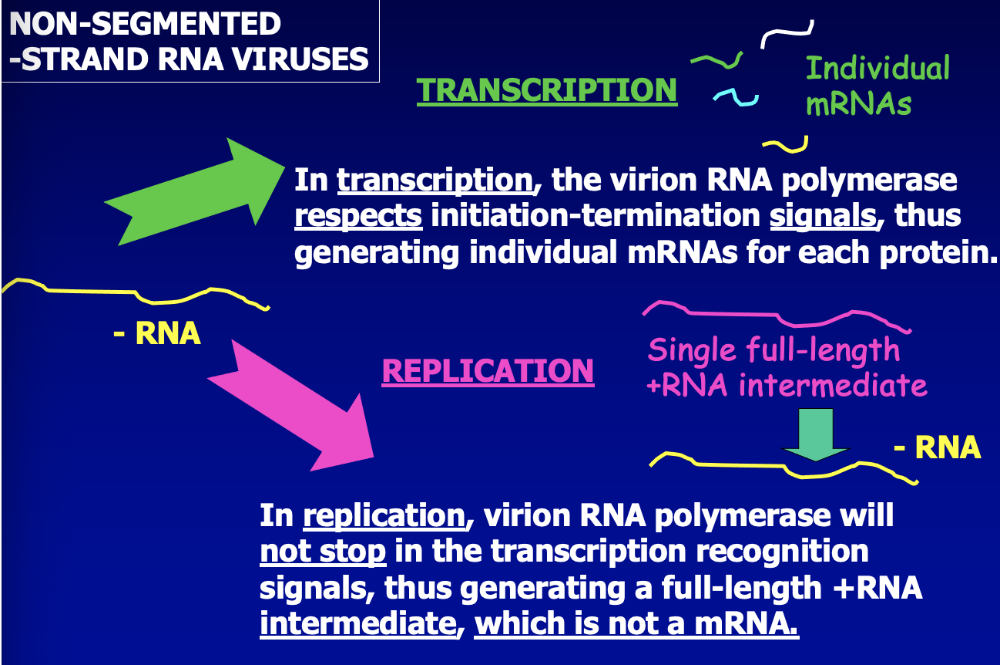
(-) RNA
- transcription
- virion RNA pol respect initiation-termination signals
- = generate individual mRNAs for each protein
- replication
- virion RNA pol will not stop in transcription recognition signals
- = generate full-length (+) RNA indermediate template = NOT mRNA
can swtch between transcription/replication mode
replication of paramyxoviruses
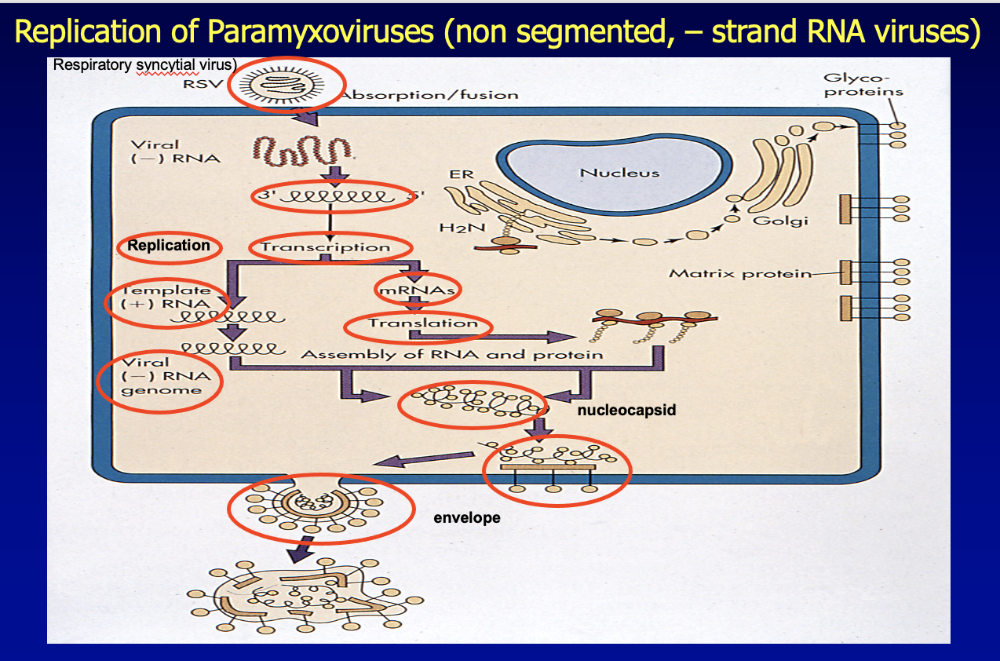
(-) genome released in cell
- Transcription mode
- Then either go down replication
or translation route
- Either made template (+) RNA or mRNA depending which it is doing
segmented (-) RNA virus
- allows for reassortment to occur
- = good for viral pathogenicity (can only do reassortment if segmented)
- diff gene segments encode diff proteins
- transcription
- viral RNA polymerase generate mRNAs from each genomic segment
- each segment contains its own signals to initiate transcription
- replication
- viral RNA pol will generate (+) RNA intermediates from each genome segment which will be copied into (-) RNA genomes
pretty much same thing as nonsegmented
flu virus
segmented (-) strand RNA virus
- replicates in host cell nucleus (this virus is the EXCEPTION)
- replicate in nucleus bc flu transcriptase use host cell 5' cap mRNA as a PRIMER for viral mRNA synthesis
consequence: viral endonuclease PB2 cuts cell's mRNA 5' cap structure as well as 10-13 nucleotides from cellular mRNA
- = capped RNA oligonucleotides function as primer for transcription initiation
- = disabling host cell protein synthesis
what is unique about the flu virus?
it replicates in the host nucleus because the mRNA's 5' cap structure is required to work as the virus' primer for transcription
= host cell cannot make any more proteins
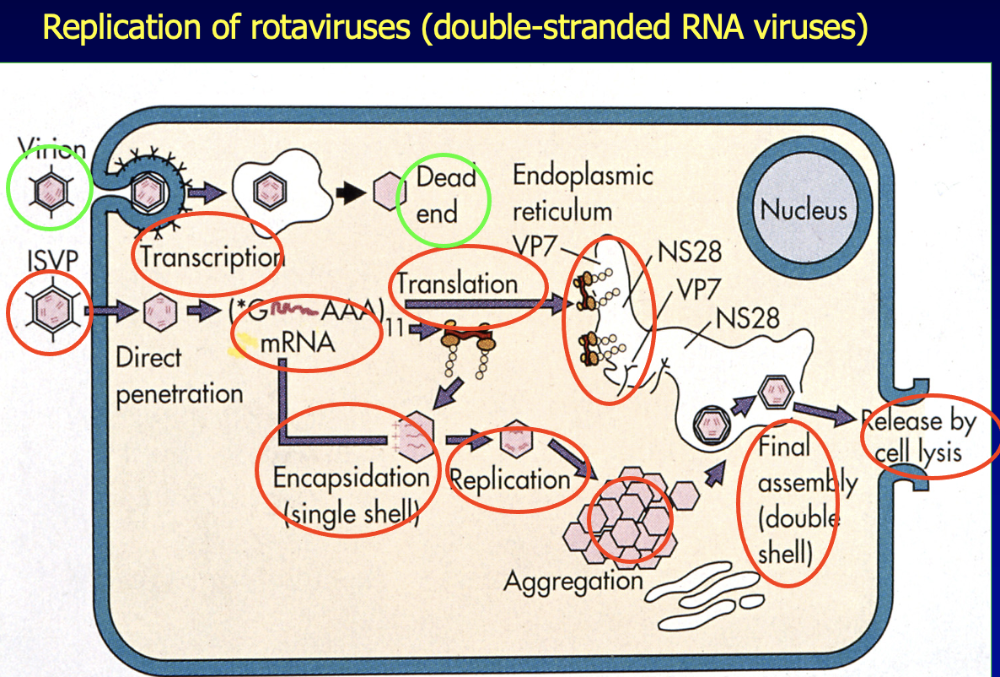
ds RNA viruses
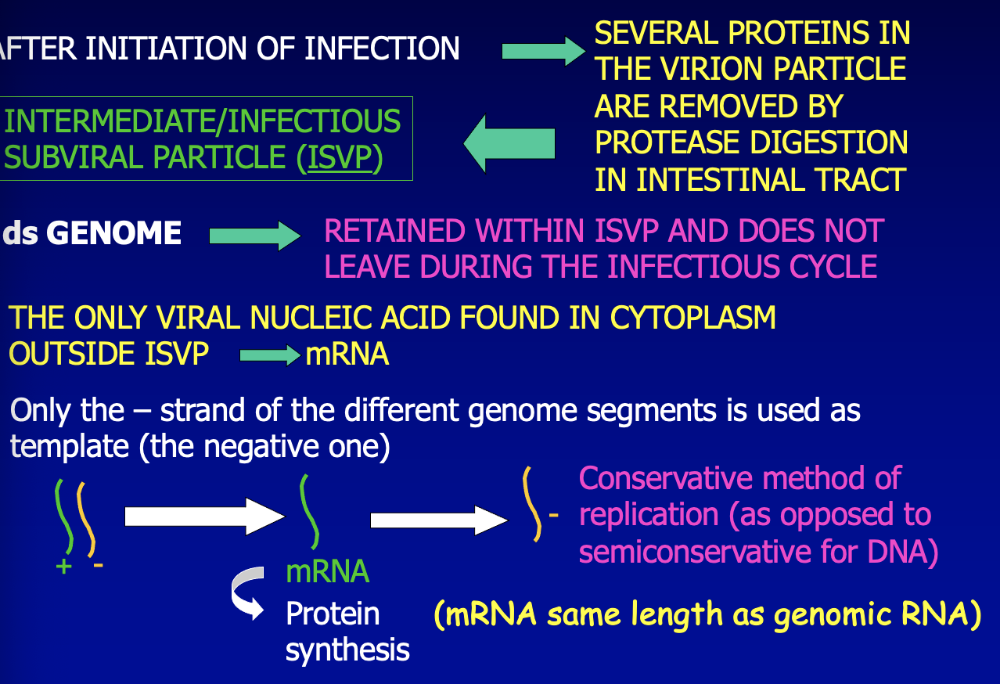
- naked - double capsid
- most - segmented genomes
- mRNA made only from one template strand of each
segment
- uses (-) strand template!!! (-> so make (+) RNA = mRNA)
-
transcription
- similar to ds DNA genome -> (-) strand template
- necessary enzymes must be encoded, packaged in virion + carried to next cell
- after infection initiation -> several proteins
in virion particle removed by protease in intestinal tract ->
form intermediate/infectious subviral particle
- this is the functional particle
- virus must become activated by GI tract - if not, gets deactivated
- virus ingested, activated by protease in GI tract
- DS GENOME - in ISVP
- but viral mRNA is in cytoplasm outside the ISVP
method of DS RNA replication
conservative replication
ISVP binds receptor (sialic acid) to ___
and whole virions are taken up by ___
penetrate the cell
receptor mediated endocytosis
ISVP
- The viral particle that has been activated by the GI tract protease which allows it to become functional and do its work in the cell upon entering
- releases core into cytoplasm
- enzymes in the core initiate mRNA production
- each (-)
strand use as template by virion core enzymes
- individual mRNAs made and mRNAs leave core to be translated
- later, virion proteins and (+) RNA segmentes form cores
- (+) RNA copied to make (-) RNA in cores = ds genome
retroviruses
- enveloped SS genome
- capsid w/ 2 identical copies of (+) strand mRNA genome
- copies of reverse transcriptase (RT) and integrase
- has 2 tRNAs - used as primers
- mRNA genome is NOT infectious bc does not encode RdRp
- encode RNA dependent DNA polymerase and replicate thru dna intermediate
- contradicted central dogma bc shows RNA can -> produce DNA (backwards)
- important in humans bc
responsible for
- HIV
- HTLV-I
- important for studied/technology
- gave rise to enzyme used for PCR
retrovirus replication cycle
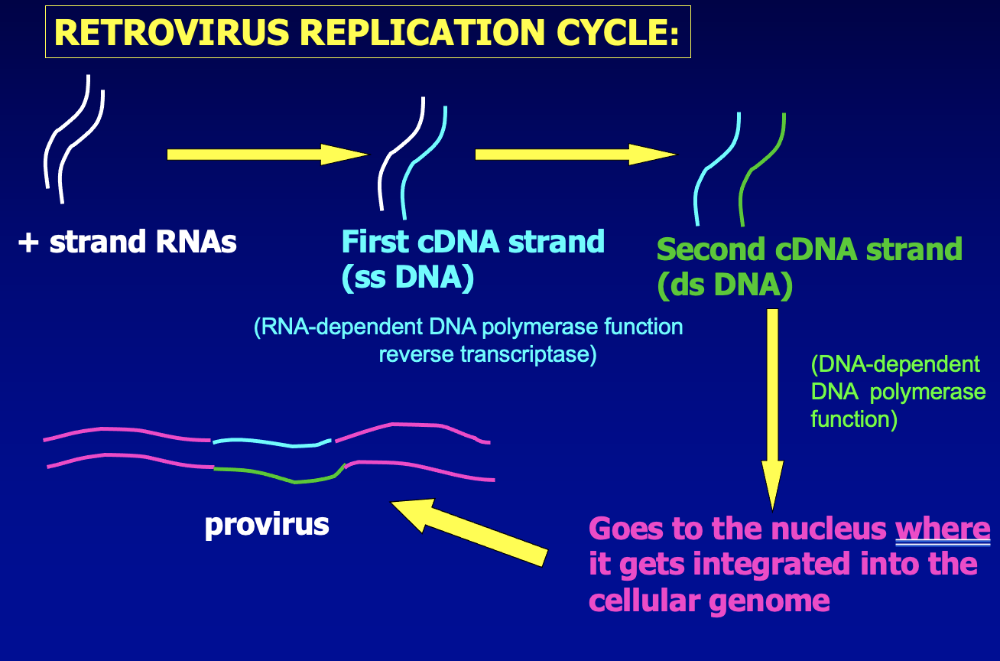
2 (+) strand RNAs
1 RNA -> give rise to cDNA strand (reverse transcriptase)
-> remaining RNA strand degraded
-> use cDNA to create complementary cDNA using DNA-depdendent DNA polymerase from host cell
-> integrate into cellular host genome
(make sure these steps are correct)
notes
Starts w/ 2 (+) strands
One + strand RNA -> make ss DNA strand using RT
Then next RNA -> ss DNA using RT
So now have ds DNA
-> nucleus
why do retroviruses have 2 copies of RNA?
not sure
maybe it increases probability of successful DNA synthesis bc if one is broken, RT can switch templated + copy the RNA = DNA synthesis
genome of retrovirus
3 major genes
- gag -> capsid proteins
- pol -> polymerase, protease, integrase
- env (envelope) -> glycoproteins
end of each RT genome = long terminal repeat sequence (LTR)
LTRs -> contain promoters, enhancers and other gene sequences used for binding of diff transcription factors
oncogenic retroviruses -> contain oncogenes
complex retroviruses (HTLV) -> encode other regulatory proteins
HIV
viral attachment to receptor/coreceptors (CCR5 and CXCR4) necessary for infection
attach CD4 (Helper T) cells exclusively
if someone does not have receptor -> they are resistance to infection
once retroviruses released into cytoplasm
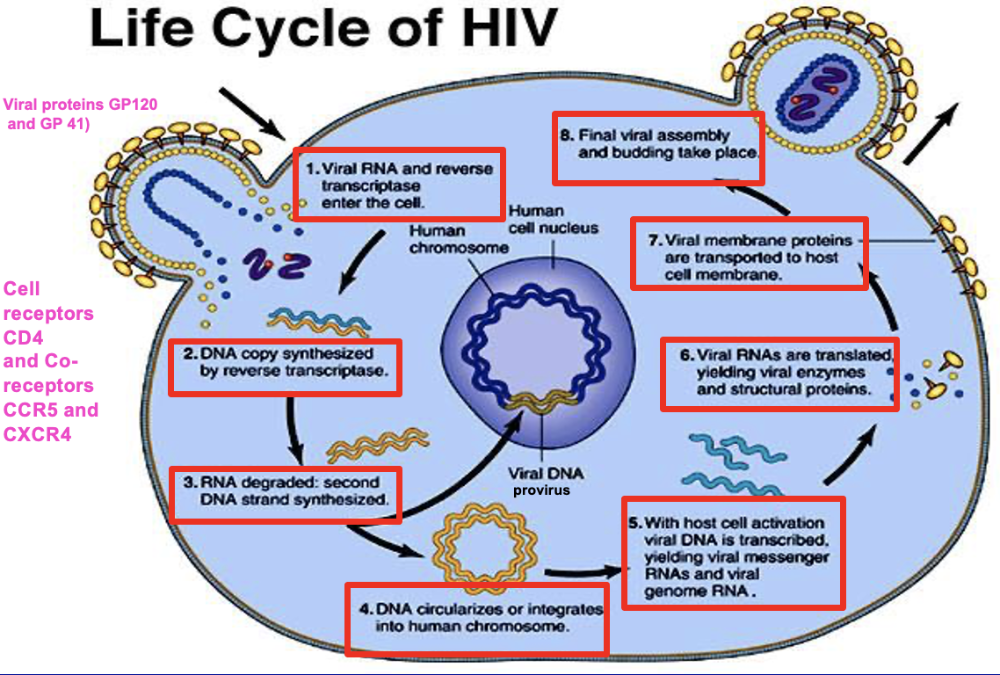
- RT use virion tRNA as primer + make complementary (-) strand DNA (cDNA)
- RT act as ribonuclease H
- degrade RNA genome left + make (+) strand DNA
- during synth of provirus, sequences from each end of genome are duplicated = attach the LTRs to both ends
- process creates sequences necessary for integration + makes enhancer and promoter regions in the LTRs for transcription regulation
- ds DNA delivered to nucleus + integrated into host chromosome
once integrated into host chromosome
- viral DNA transcribed (in the cell's genome) by the host's RNA pol II
- = full length RNA
- can either:
- proceed to make
- mRNA
- translation = proteins
- assemble into new virions
- proceed to make
- can either:
RT OCCURS WITHOUT FULL UNCOATING OF THE GENOME
RT OCCURS WITHOUT FULL UNCOATING OF THE GENOME
Nucleocapsid partially dissolved
WHICH EXPLAINS WHY THE GENOME (mRNA) IS NEVER TRANSLATED
(thus not full genome is used)
virus acts as cellular gene so its replication depends on:
- extent of methylation of viral DNA
- cell's growth rate
- ability of cell to activate enhancers + promoters encoded in the lTR
stimulation of the cell by mitogens, certain lymphokines, or infection of the cell w/ exogenous viruses produces transcription factors which bind LTR + activate viral transcription
viral oncogenes promote cell proliferation = stimulate transcription and viral replication
comparison of (+) strand RNA viruses and retroviruses
